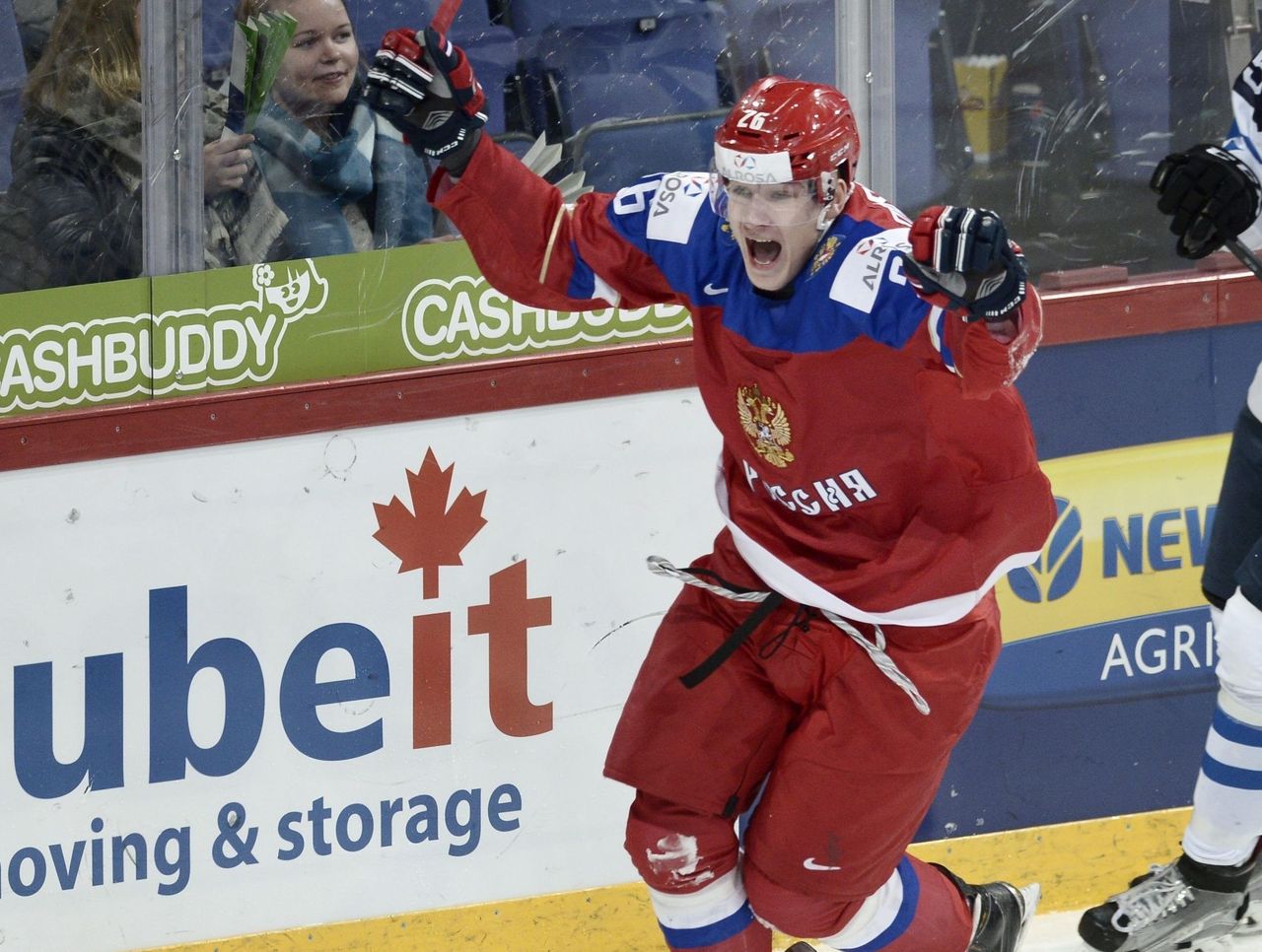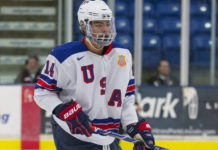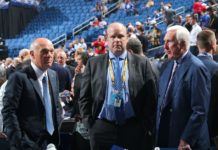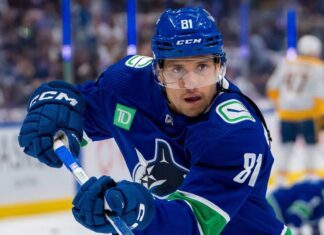In the 2016 draft, the critics say the Leafs fell back into their old ways, and went after Bottom 6’ers.
Apparently, they just picked older kids. Over-agers. Ones the Leafs thought could slot in as Bottom 6’ers in the NHL or in the AHL right away. Big bodies, most of them, and maybe a bit slow. But we’d save a few bucks, and protect all those skilled kids we got last year.
At least, that’s the word I hear from the analysts in the know.
To listen to them, this Leaf draft was pretty disappointing.
I mean, just as one example, take that Russian kid. It was probably worth getting him, but using up a 2nd round pick on him?
Whoa.
Worse yet, the kid was over-age. Way over-age, as in draft + 2. He turns 20 in July.
Not. Good.
Okay, fair enough, he made the Russian men’s league, and put up 12 points in 30 or 40 games or so, which is okay, but he’s no Pavel Bure.
And sure, the kid is big. He’s probably going to end up around 220 pounds. Big kids take more time. We know that.
Also on the plus side, he kicked the tar out of the World Juniors, scored some nice goals, and put on a show with his line-mates.
Fact is though, even if we add all that up, he’s still almost 20 years old. That’s bottom six material. So of course we’re going to be disappointed in that pick.
Even if he did turn out to be Nik Kulemin.
Say what?
Kulemin. Nik Kulemin. That is who we’re talking about, right?
Because the 20 year old Russian kid picked a decade ago was… Nik Kulemin. And just like Yegor Korshkov this year, he was picked by the Leafs in the second round.
And just like Korshkov, Kulemin was a draft+2 over-ager. In fact, they almost have the same birthday… and both got drafted as young wingers playing in the Russian bigs.
Over-Age? Not Over There.
Maybe let’s take a second look at this “over-age” thing.
In North America, we all focus on the CHL and its particular timeline for development. And we all know how Canadian kids are directed, from damn near since birth, to hit certain time slots so they can show their stuff by their age-18 year.
The thing is, the human body and psyche aren’t locked into this pattern. And you know what?
Kids in other countries aren’t locked into this timeline. Sure, some are aiming at the NHL draft window. But for an awful lot of European and Russian kids, their families and their coaches and development processes aren’t.
That is why an awful lot of European and Russian kids only really show up when they’re past their 18th birthday.
I know, I know. I must be wrong because I’ve heard so often that picking over-agers is just targeting bottom six filler — a waste of a pick — and that these “late developers” are rare as unicorns. “Just look at the evidence,” they say. Which all points to how we should pick younger kids.
Like with the Leafs.
Oh, wait:
- Nik Kulemin was draft + 2
- Leo Komarov was draft + 1
- Anton Stralman was draft + 2
- Carl Gunnarsson was draft + 2
- Viktor Stalberg was draft + 2
Oh, and then there’s Rinat Valiev, draft + 1, as well as Viktor Loov.
Oh, Nikita Soshnikov and Nikita Zaitsev. They weren’t drafted by the NHL at all, ever.
That’s just Leaf players from the last decade. Before that, there was Danny Markov, Modin, Berezin, Borschevsky and Mironov.
Look, the official wisdom about picking older players has a hole in it. A hole roughly the size of Europe.
And one that Thommie Bergman has apparently been long aware of.
Sometimes, even if we’re smart and study the numbers, the things we think turn out to be wrong.
Target The Undervalued… And The Underperforming
Truth is though, we’ve learned some things about draft picks in these recent years. For instance, we’ve learned that a lot of NHL teams under-value smaller players. And that this may, in fact, be really dumb.
Johnny Hockey says hello.
That was a good new idea to learn, because it went against the trend of decades worth of hockey thinking. For example, the Leafs idiotic preference for big, slow guys. So it was nice to see the Leafs draft Mitch Marner last year, and Timashov, and Bracco.
But we’ve learned other things about drafting as well:
Other things being equal, it’s better to draft a young guy than an older one. Even within a draft year, if the stats are equal, you take the younger one.
Also, we now know we should draft more for home runs — pick kids with a high upside — rather than just go for fodder for the Bottom 6 because you can always pick up Bottom 6 players as free agents or as throw-ins in trades. Use your picks to aim high.
We learned that you should draft guys who can skate. The NHL is getting faster and faster, and a defence corps made up of Brute Squad members isn’t such a grand idea. O’Byrne, Oreskovic, Exelby and Aulie say hello.
We’ve also learned that we should probably draft for the Best Player Available (BPA) instead of picking 18 year olds to fill a hole on an NHL roster. No more 18-year-old defencemen shoved into the NHL too soon, okay?
And, on average, I’d agree with each one of these things. Teams should target smaller players when they’re undervalued… and younger ones, all else being equal… and ones with the higher upside… and good skaters… and aim to pick the BPA.
On average, you should do that. On average.
All these things are good pieces of advice.
On average.
But here’s the sting: In an NHL draft, a real smart team may well be looking to go off average. To move off the consensus draft rankings.
Sure, when you pick in the top 5, you probably follow the consensus because the very best of the best players have been analyzed — by 1,000 eyes — in every single way imaginable. There’s going to be pretty strong information there.
But with every pick you move down the draft board, the information gets patchier, the unknowns grow, and the possibilities — the potential for a kid to soar or to crash — widen.
What you really want to find is not some consensus pick — some fairly talented kid who performed fairly well — but a kid who actually has first round talent, but who underperformed somehow, or fell off the scouting radar, or who got undervalued for some reason.
It’s those kids — the undervalued & underperforming, i.e. hockey’s crap-heap — who are precisely the ones you and your scouts most need to dig out.
By now, we’ve all seen how a player can be ranked too low because of the prejudices and blind spots of teams and scouts. Like with smaller players, or — as we explored last Summer — how the Leafs had been [stupidly] opposed to picking European kids [Russians in particular].
But beyond the blind-spots and irrationalities of scouts and managers, there are a whole lot of other reasons why a hockey player can underperform his peers. If a team’s scouts can see those reasons, and believe those kids’ potentials can still be tapped, they’re going to be able to mine veins of talent other teams won’t even see.
- For instance, maybe they know that a kid got sick and was underperforming or behind on his development because of that. Take Leaf pick Andreas Johnson, for instance, who was held back by undiagnosed asthma. After that was better managed, his totals soared.
- Or the kid whose team is so bad he barely gets to see the other team’s end of the ice. [Not only will this often drag their stats down, they often have to deal with coaches doing dumb things.] [Hi Randy.]
- Or the players who simply get buried because a team is deep in talent, or their coach hates them, and so they get barely a sniff of ice time.
- Then there are the European and Russian kids having to adjust to North American ice and life. Rinat Valiev effectively lost a year of junior play to chaos as he came over.
- And then there are the kids who are physically big, and just not as comfortable and coordinated in their movements as kids who have finished their growth. They’re often facing huge growth spurts in a year when they’re supposed to be looking smooth and finished on ice.
What you want is for your scouts to find these kids — kids who have “underperformed” somehow. The more the better, actually.
Sure, it’s great on draft day when a kid ranked #49 “falls” to you at #57. That’s what most of us watching the draft on TV look for.
The chances of that difference turning into a big NHL advantage are almost nil. But when you find a kid whose potential is actually that of a #12 pick — who could become a real top six player — and you pick them up at #87 or #122?
That’s gold, Jerry.
Gold.
***
In reality, there are lots of kids with more potential than they’ve shown, of at least, who have more talent than is captured in the consensus draft ranking. The difficulty is that most of them are lost, and will remain lost.
What a good scout or management team has to do is find the subset of those kids where:
- You know what went wrong with their game or their year — why they underperformed, or weren’t well identified by the scouts.
- Then, if something is wrong, you have to know you can fix it.
- And ideally, you’d prefer that other teams haven’t spotted this potential. If everyone sees it, their ranking gets pushed up, right?
These are the kids who you stand to gain the most from — the outliers, the gems. These are the ones who form the potential home runs.
But here’s the cold part of that — the slap of a wet fish to the face. If our team is doing a great job of drafting, they will often land players where even we don’t see the value.
Because we’re not privy to what they’re seeing, right? So if they play their cards right, it’ll look to us like the team just made a bad pick.
That’s right: A really good draft pick may look, to those of us not on the inside, like an idiotic decision.
For example, everybody in the NHL now knows to look for smaller players, and not to under-value them too much. So, the list of small players that went in round #1 or #2 this year was enormous. Just take the kids under six feet tall: There was Keller and Jost, Kunin and Steel, Mascherin and Debrincat, Asplund and Dahlen, Girard and Dube, with Fox, Bitten and Abramov coming at the start of the third round. A batch of these kids weighed down around 160 pounds. Not big.
Which means that, suddenly, smaller players aren’t being undervalued nearly as much. The room for a big competitive advantage on this point has been eaten up.
Similarly, much of the advantage of drafting from Europe is now gone. After my complaint last year that the Leafs needed to pay more attention to Finland, this year turned into the Year of the Finn. Much of that advantage was eaten up as well.
But for the Leafs scouting team, the answer to those advantages disappearing is not to simply fall back on the standard draft ranking, and pick the next highest consensus pick, or the kid with the higher PPG.
It’s to take a risk.
Go further out into the water. Go fishing for talent on the basis of new and surprising ways of identifying undervalued kids.
Which is just what the Leafs did.
- They took over-agers, because they spied an opening there. The 3 Russians, as we discussed, but also two WHL kids.
- And they took Russians also because the NHL still doesn’t weigh the risks and rewards there very well.
- They took kids off really bad teams [Like Chebykin, whose 35 points this season came on a team where nobody else had over 23].
- They took a kid who got sick, but who also changed position late in his development [Jack Walker].
- They took a kid who got buried on a good team [Mattinen, on London].
- They took a Russian kid who had a lost year coming to North America [Bobylev, who went from 9 to 67 points this year].
- They picked three really big defencemen [and maybe one will learn to skate well enough to turn into a… monster].
The Leafs went fishing.
Thing is, we just didn’t expect them to reel in the ones they did.
Hey Critics: Smarten Up and Just WATCH This Yegor Korshkov Kid, Willya?
Now, rather than go into all the picks, let’s spend a minute just on Korshkov, and see if we can see what the Leafs saw.
First off, Korshkov is best known for leading his Russian WJC teammates to a silver medal, missing gold by an inch to Finland. And he led the Russians in scoring with 8 points in 7 games.
To compare him with a Russian pick of the same age, last year Detroit picked Evgeni Svechnikov at #19. Svechnikov is also a big winger at 6’2” and 200 pounds. Now, the WJC is only one tournament, but in it Svechnikov had 0 points, while Korshkov had 8.
Just sayin’.
Another big Russian winger that Korshkov outshone was Alexander Dergachev, who went to the LA Kings last draft. Dergachev only had 2 points.
When Korshkov went back to Russia, he also led his Junior team to the championship, and led the playoffs in scoring with 19 points in 15 games.
So, the Leaf pick people are crapping on just led all Russian Juniors in scoring at the WJC, and then led them again in scoring during their Memorial Cup equivalent.
Meanwhile, in the same season [and he played 86 games in total last year; a lot of hockey], he also played as a 19-year-old in the KHL. Which means, in Russia, that he got to prop up the bench and watch the veterans [which Soshnikov and most other Russian youngsters go through].
So, in his first 21 KHL games this year, Korshkov only put up three points. But then the coach began shoving a bit more ice time at him [roughly 10-12:00 per game], and Korshkov’s scoring rose accordingly, adding 9 points in his last 20 games.
In fact, while that looks low, it was actually second best for all Russians under-20 in the KHL, and well ahead of highly-touted picks like Dennis Guryanov [the Dallas #12 pick who got 5 points in 47 games], or Alexander Dergachev [2 points in 33 games.]
***
Now for some wider things the Leafs almost assuredly knew about Korshkov.
First off, his size. He’s officially almost 20 years old now, and stands 6’ 4”. But while he’s been shooting up, he doesn’t yet have the weight as he carries just 179 pounds. He needs to add muscle. Once he does, if he can carry it, skate with it and use it, he’ll be much more of a player than he is now.
Which is why you need to hear about his dad [Like Timashov’s dad last year, the wrestler].
Korshkov’s dad is named Alexei, and Alexei Korshkov played defence for Russian teams for 18 years.
Anyway, the old man stood 6’ 5” and weighed 247 pounds. He’s a monster.
Watch him in this fight. The guy he’s beating on is 205 pounds:
That’s the old man.
And what I’m saying is, that if young Yegor adds even half that weight as he fills out, he’s going to be a 6’4” and 220 pound power winger.
And wait ’til you see the soft hands on this kid.
First though, the not-so-soft hands of Korshkov Jr. Here he is at age 19 against Sami Lepisto:
Second, beyond size, there are other reasons to believe that Korshkov’s development was delayed. That thing about where you grew up, and then have to move to play better hockey? Well, Korshkov’s dad ended his career playing in Kazakhstan, so young Yegor grew up learning hockey and playing there from age 8 to 16.
Which was fine, but it’s tough to get into certain competitions from there, and your learning curve isn’t ideal. For instance, at age 15, young Korshkov had to play against grown men, and on a really bad team — one that got outscored 297 to 98 over the season. He was third highest scorer on the team, but ran a -44. Maybe not the best learning environment for Korshkov compared to other kids in bigger cities.
Anyway, Korshkov moved the next year to play for Lokomotiv Yaroslavl’s system, and he tore it up. Thing is though, the year after was his draft year already, and he just plain wasn’t ready.
Growing up big in Kazakhstan, you maybe end up a “late bloomer.”
Third, in terms of how Korshkov plays today, those who have seen him mention how he’s strong on his skates, how he’s training to improve his explosiveness, is a good stick-handler, can win board battles and cycle, plays smart, and has a good hockey IQ. On the downside, they all mention that 179 pounds is too lean, and he needs to add weight.
But, just like with Soshnikov, you really do need to see him in action. When they say he handles the puck, they mean it. This kid is a power winger at age 19.
But just WATCH this winning goal he scored at the World Juniors against the US. From 1:15 on:
Now, tell me how a 6’ 4” winger who can do that isn’t worth at least thinking about?
Those are JVR’esque moves.
So sure, he’s older than most draft picks, and he’s bigger.
But I’m not convinced Korshkov is some hulking, slow-moving, slow-thinking Bottom 6’er we drafted as cheap filler.
***
P.S. Remember That Russian 5 Thing?
Remember last year, when Soshnikov played for a team where Kozlov, Namestnikov and Kudashov all had ties to Shanahan and Hunter?
This year, Korshkov’s head coach and assistant coach were, once again… Kudashov and Namestnikov.
And how are we scoring on our Russian 5 project? Well, the Leafs just added three more Russians — Korshkov, Bobylov, Chebykin — to Zaitsev and Soshnikov, who came to Toronto as free agents. Added to last year’s picks, Dzierkals and Timashov [both ex-Soviet Union] and Korostelev, and Valiev from the year before. Of course, we already had Komarov [ex-Soviet Union] to show them the ropes.
The Leaf Russian 5.
Now with 100% more Korshkov.




































